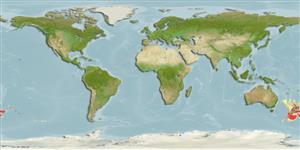Environment: milieu / climate zone / depth range / distribution range
Ecology
Marine; bathydemersal; depth range 200 - 1300 m (Ref. 26346). Deep-water
Southwest Pacific: endemic to New Zealand.
Size / Weight / Age
Maturity: Lm ? range ? - ? cm
Max length : 51.0 cm TL male/unsexed; (Ref. 26346)
Short description
Identification keys | Morphology | Morphometrics
Dark brown in color (Ref. 26346). Wing tips rounded; snout shorter than most other skates; skin smooth, soft and loose, with band prickles on hind body and tail (Ref. 26346).
Inhabit the continental slope (Ref. 26346). Oviparous. Distinct pairing with embrace. Young may tend to follow large objects, such as their mother (Ref. 205). Eggs are oblong capsules with stiff pointed horns at the corners deposited in sandy or muddy flats (Ref. 205). Egg capsules are 3.7 cm long and 2.2 cm wide (Ref. 41249).
Life cycle and mating behavior
Maturities | Reproduction | Spawnings | Egg(s) | Fecundities | Larvae
Oviparous (Ref. 26346). Paired eggs are laid. Embryos feed solely on yolk (Ref. 50449). Distinct pairing with embrace. Young may tend to follow large objects, such as their mother (Ref. 205).
McEachran, J.D. and K.A. Dunn, 1998. Phylogenetic analysis of skates, a morphologically conservative clade of elasmobranchs (Chondrichthyes: Rajidae). Copeia 1998(2):271-290. (Ref. 27314)
IUCN Red List Status (Ref. 130435)
Threat to humans
Harmless
Human uses
Tools
Special reports
Download XML
Internet sources
Estimates based on models
Phylogenetic diversity index (Ref.
82804): PD
50 = 0.5039 [Uniqueness, from 0.5 = low to 2.0 = high].
Bayesian length-weight: a=0.00550 (0.00273 - 0.01106), b=3.10 (2.93 - 3.27), in cm total length, based on LWR estimates for this (Sub)family-body shape (Ref.
93245).
Trophic level (Ref.
69278): 3.8 ±0.7 se; based on size and trophs of closest relatives
Resilience (Ref.
120179): Low, minimum population doubling time 4.5 - 14 years (Fec assumed to be <100).
Fishing Vulnerability (Ref.
59153): Moderate vulnerability (40 of 100).
